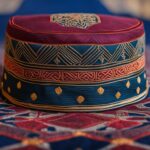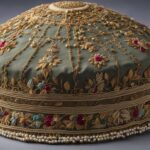A chapel veil or mantilla is a traditional Christian prayer tool that holds significant cultural and religious symbolism. It is a circular veil with a lace trim around the entire edge, and it has been worn by Spanish, Latin, and Italian brides for centuries. The veil is typically worn on top of the head about two inches behind the hairline, allowing the lace edge to drape elegantly alongside the bride’s face. Mantilla veils are often adorned with intricate embellishments cascading down the front, adding to their elaborate elegance.
Key Takeaways
- A chapel veil or mantilla is a traditional Christian prayer tool with cultural and religious significance.
- Mantilla veils are circular veils with lace trim and are worn by Spanish, Latin, and Italian brides.
- These veils drape elegantly alongside the bride’s face and often have intricate embellishments.
- Chapel veils or mantillas have a rich history and are worn for both weddings and Mass.
- These veils symbolize respect for religious customs and can vary among different sects.
The History and Meaning of Chapel Veils or Mantillas
Chapel veils or mantillas have a rich history and hold deep cultural and religious significance. These traditional Christian prayer tools are particularly prevalent in Spanish, Latin, and Italian cultures, where they have been worn for centuries. While they are commonly associated with weddings, mantilla veils are also traditionally worn to Mass, with different colors symbolizing the marital status of women.
In Catholicism, mantilla veils are a symbol of respect for the sacredness of the occasion and are often mandated by traditional Catholic churches for wedding ceremonies. The veils are worn on top of the head, with the lace edge draping elegantly alongside the bride’s face. They also serve the purpose of covering the bride’s shoulders during the Mass.
While mantilla veils are most commonly associated with Catholicism, variations of chapel veils can be found across different Christian sects and cultural traditions. These veils are not limited to weddings in Catholic churches and can be worn by anyone who wishes to honor their heritage or embrace the cultural significance and elegance of chapel veils.
“Chapel veils or mantillas have a rich history and hold deep cultural and religious significance.”
Table: Variations in Chapel Veils or Mantillas
| Sect | Cultural Significance |
|---|---|
| Catholicism | Mantilla veils are mandated for Catholic wedding ceremonies and symbolize respect for the sacredness of the occasion. |
| Other Christian Sects | Chapel veils are worn to embrace the elegance and tradition of mantilla veils, regardless of religious affiliation. |
The materials used in chapel veils or mantillas add to their beauty and uniqueness. Most often, delicate and intricate lace is used, with scalloped edges being a hallmark of mantilla veils. Other fabrics such as tulle and netting can also be used, offering different textures and styles to suit individual preferences.
Over time, chapel veils or mantillas have evolved in design and cultural significance. While they have maintained their timeless elegance, modern variations of mantilla veils include different lengths and lace patterns. Brides now have the freedom to choose personalized embellishments such as beads and embroidery, adding a contemporary touch to this traditional accessory.
While the mantilla veil is one of the most well-known chapel veil variations, there are other lesser-known styles to consider. Some alternatives include birdcage veils, blusher veils, and shoulder-length veils, each offering a distinct look and feel to suit a bride’s individual style and preferences.
“Modern variations of mantilla veils include different lengths and lace patterns, allowing brides to choose personalized embellishments for a contemporary touch.”
Variations in Chapel Veils or Mantillas Across Sects
While mantilla veils are commonly associated with Catholicism, they are not exclusive to this sect. Variations in the use of chapel veils or mantillas can be observed across different Christian sects and cultural traditions. For example, many Hispanic and Italian weddings take place in Catholic churches, where mantilla veils hold immense cultural significance. However, anyone can choose to wear a mantilla veil, whether to honor their heritage or celebrate the surrounding culture in a destination wedding. These veils are a versatile and timeless accessory that transcends religious boundaries.
Variations in Catholic Chapel Veils
Within Catholicism itself, there are variations in how chapel veils or mantillas are worn. Different dioceses and individual churches may have specific guidelines regarding the length, color, or style of the veil. In some places, it is customary for women to wear a veil that covers the head completely, while in others, a smaller chapel veil or mantilla that covers the shoulders may be sufficient. These variations reflect the diversity of traditions and customs within the Catholic faith.
Mantillas in Different Cultures
Outside of Catholicism, mantilla veils can also be seen in other cultural traditions. For example, in Spanish and Latin American cultures, mantilla veils are often worn by brides as a nod to their heritage and to embrace the elegance and beauty associated with these veils. In Italian culture, brides may wear a similar style of veil known as a “mezzetta,” which is often paired with a lace gown. These cultural variations highlight the significance of mantilla veils as a symbol of tradition and identity.
Materials Used in Chapel Veils or Mantillas
Chapel veils or mantillas are exquisite accessories that showcase intricate craftsmanship and timeless elegance. These veils are typically made from delicate and beautiful lace, which is the hallmark of a mantilla veil. The lace trim adds a touch of femininity and sophistication to the veil, creating a stunning frame for the bride’s face. The lace used in chapel veils is often scalloped, with intricate patterns and designs that enhance the overall aesthetic.
In addition to lace, tulle and netting are also common fabrics used in the creation of chapel veils or mantillas. Tulle is a fine, lightweight fabric that adds a soft and ethereal quality to the veil. Netting, on the other hand, is slightly heavier and has a more structured appearance. These fabrics can be used in combination with lace to create unique and stunning designs.
When choosing a fabric for a chapel veil or mantilla, brides can consider the overall style and feel they want to achieve. Lace veils exude a classic and romantic vibe, while tulle and netting veils offer a more modern and contemporary look. The choice of fabric ultimately depends on the bride’s personal style and preferences.
Table: Comparison of Veil Fabrics
| Veil Fabric | Characteristics |
|---|---|
| Lace | Delicate, intricate patterns, feminine |
| Tulle | Lightweight, soft, ethereal |
| Netting | Structured, slightly heavier |
Overall, the materials used in chapel veils or mantillas contribute to their exquisite beauty and add a touch of luxury to the bride’s wedding ensemble. Whether it’s the intricate lace, the soft tulle, or the structured netting, these fabrics elevate the bridal look and make the bride feel like a true princess on her special day.
Evolution of Chapel Veils or Mantillas Over Time
Over the centuries, chapel veils or mantillas have witnessed an evolution in both design and cultural significance. While these prayer tools have retained their timeless elegance, there have been notable changes in the style and embellishments used in mantilla veils. Modern brides now have the freedom to choose from a variety of designs, including different lengths and lace patterns, to create a more personalized and unique look.
Historically, mantilla veils were characterized by their delicate scalloped lace trim and tulle or netting material. However, in recent years, the design possibilities have expanded. Brides can now find mantilla veils adorned with intricate beadwork, embroidery, and other modern embellishments. These additions bring a contemporary touch to the traditional bridal look, allowing brides to showcase their individual style and preferences.
“The evolution of chapel veils or mantillas reflects the changing tastes and preferences of modern brides. While the symbolism and cultural significance remain intact, the designs have become more diverse and customizable than ever before,” says wedding fashion expert Emily Thompson.
Furthermore, the modernization of mantilla veils has also led to an increase in the use of alternative fabrics and materials. While lace remains a popular choice, brides can now opt for tulle, netting, or even silk for their veils. These different fabrics offer unique textures and styles, allowing brides to find the perfect match for their wedding gown and overall aesthetic.
| Mantilla Design Changes | Cultural Significance | Materials Used |
|---|---|---|
| Expansion of design possibilities | Celebration of individual style | Lace, tulle, netting, silk |
| Incorporation of modern embellishments | Symbolism and tradition maintained | |
| Diverse lace patterns and lengths | Customized to suit personal preferences |
The historical evolution of chapel veils or mantillas reflects the changing tastes and preferences of modern brides. As they continue to be cherished symbols of tradition and elegance, these prayer tools have adapted to the contemporary bride’s desire for individuality and personal style.
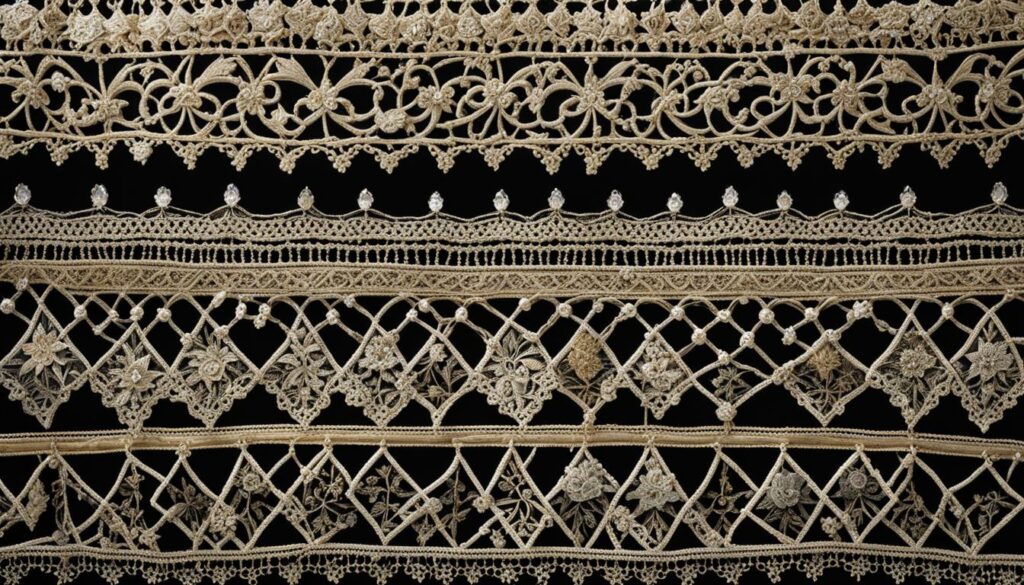
Lesser-Known Chapel Veil or Mantilla Variations
While the mantilla veil is one of the most well-known chapel veil variations, there are other unique and lesser-known styles that brides can consider to add a touch of individuality to their wedding day look. These alternative veil styles offer versatility and can complement different wedding dress styles and personal preferences.
Birdcage Veils
Birdcage veils are a popular choice for brides seeking a vintage-inspired look. Made from netting, they cover the face delicately, exuding a sense of mystery and allure. They are often paired with lace or feather embellishments to add a touch of elegance. Birdcage veils are perfect for brides looking to make a statement and add an element of Old Hollywood glamour to their wedding ensemble.
Blusher Veils
Blusher veils create a soft and romantic feel. These veils are shorter in length and fall just below the chin, gently framing the bride’s face. They can be worn alone or in combination with a longer veil for a dramatic effect. Blusher veils are a popular choice for brides seeking a classic and timeless bridal look.
Shoulder-Length Veils
For a more modern and contemporary option, brides can opt for shoulder-length veils. These veils end at the shoulders and offer a more relaxed and casual look. They are perfect for brides who want a veil that doesn’t extend beyond their shoulders and prefer a more minimalistic approach. Shoulder-length veils are versatile and can be paired with various hairstyle options, from updos to loose waves.
By considering these lesser-known chapel veil variations, brides can find the perfect accessory that reflects their unique style and adds a touch of individuality to their wedding day look. Whether it’s the vintage-inspired charm of a birdcage veil, the soft romance of a blusher veil, or the contemporary appeal of a shoulder-length veil, these alternative styles offer brides the opportunity to showcase their personality while maintaining the timeless elegance of a bridal veil.
Choosing the Right Chapel Veil or Mantilla for Your Wedding Dress
When it comes to choosing a chapel veil or mantilla for your wedding dress, there are a few key considerations to keep in mind. One of the most important factors is ensuring that the veil matches and complements your gown. This means taking into account the lace or embellishments on your dress and selecting a veil that coordinates with these elements. The goal is to create a cohesive and harmonious look that enhances the overall beauty of your wedding attire.
In addition to matching the lace and gown, it’s also important to consider the hairstyle you’ll be wearing on your wedding day. Different hairstyles will determine the placement and style of the veil. For example, if you’re wearing your hair down in long waves, a mantilla veil can be draped over the top of your head, showcasing the elegance of the lace and adding a touch of romance to your look.
When selecting a chapel veil or mantilla, it’s helpful to consult with a bridal stylist or expert who can guide you through the process. They can provide recommendations based on your dress style, personal preferences, and overall wedding theme. Ultimately, the goal is to choose a veil that not only complements your dress but also reflects your unique style and enhances your natural beauty on your special day.
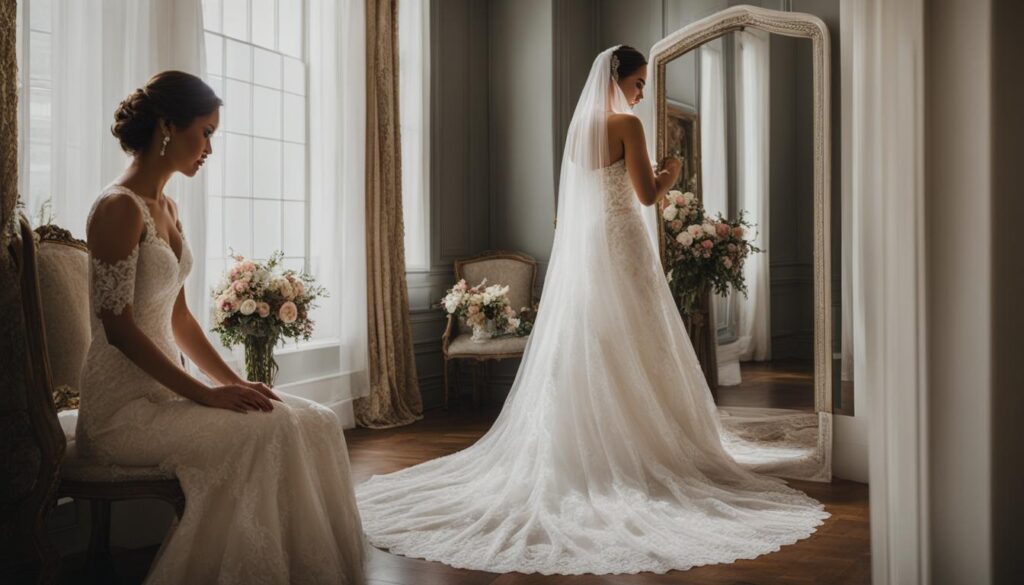
Table: Veil Length Options
| Veil Length | Description | Suitable Hairstyles |
|---|---|---|
| Cathedral Length | Extends beyond the train of the gown, creating a dramatic and regal look. | Updos, ballgown dresses |
| Chapel Length | Falls just below the train of the gown, offering a classic and elegant appearance. | Half-up half-down, mermaid dresses |
| Elbow Length | Reaches the elbows, adding a touch of sophistication and charm. | Short hairstyles, sheath dresses |
| Fingertip Length | Extends to the fingertips, creating a versatile and flattering look. | Updos, A-line dresses |
As seen in the table above, there are various veil length options to choose from, each suitable for different dress styles and hairstyles. It’s important to select a length that complements your overall look and enhances the silhouette of your gown. Whether you opt for a dramatic cathedral veil or a chic elbow-length veil, the key is to find a balance that harmonizes with your dress and enhances your bridal beauty.
Wearing and Securing a Chapel Veil or Mantilla
When it comes to wearing a chapel veil or mantilla, proper placement and securing are crucial to achieve the desired elegance and comfort. Here are some tips on how to secure a veil with a comb and ensure a beautiful look throughout your special day.
To begin, it’s important to note that some veils come with an attached comb, while others require a separate comb or pin for proper attachment. Regardless of the type of veil you choose, the first step is to ensure your hair is styled accordingly. If you plan to wear the veil at the top of your head, it’s recommended to have an updo or a hairstyle that allows for easy comb placement.
To secure a chapel veil with a comb, start by positioning the comb at the top of your head, approximately two inches from the hairline. Make sure the comb is inserted firmly into your hair, creating a secure anchor for the veil. If needed, use additional bobby pins that match your hair color to secure the veil and prevent any slipping during the ceremony.
For mantilla veils that require a peineta (a decorated high comb), follow a similar process. Insert the peineta into your hair, ensuring it is securely fastened. Then, drape the mantilla veil over the peineta and adjust it to the desired positioning. You can allow the veil to cascade gracefully over your shoulders or create a more dramatic look by positioning it further back.
By following these steps, you can confidently wear your chapel veil or mantilla throughout your wedding day, knowing that it is securely attached and complements your overall bridal look.
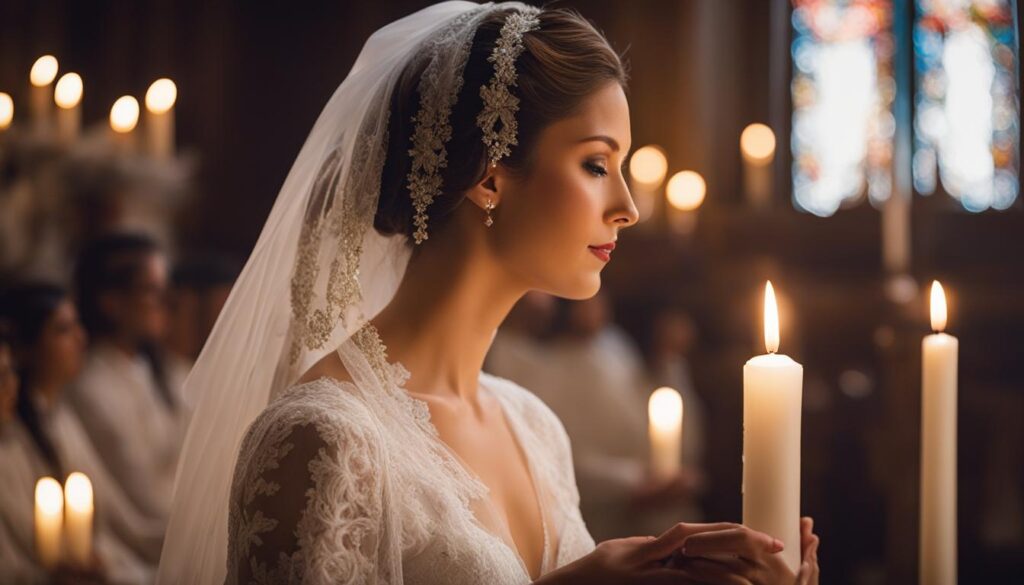
Mantilla Veil During Catholic Service
Mantilla veils hold immense cultural and religious significance in Catholic wedding ceremonies. The tradition of wearing mantillas during a full Catholic service in a church stems from the practice of honoring the sacredness of the occasion and covering the bride’s shoulders during Mass. The mantilla veil, with its delicate lace and scalloped edge, adds an elegant touch to the bride’s wedding day look.
To keep the veil intact and secure during the ceremony, it is important to ensure proper attachment. Many mantilla veils come with an attached comb, which should be secured at the top of the head, approximately two inches from the hairline. It is recommended to use bobby pins that match the hair color to prevent the veil from slipping during the ceremony. Additionally, it is advisable to wait until you arrive at the church to put on the veil to avoid any potential pre-wedding mishaps.
After the ceremony, many brides choose to keep the mantilla veil on for bridal pictures, as it adds a touch of elegance and tradition to the photographs. However, some brides may opt to remove the veil before the reception, especially if it is a cathedral length veil, to avoid it being stepped on or causing any damage to the veil or hairstyle. Ultimately, the decision to keep the mantilla veil on or remove it during the wedding day is entirely up to the bride’s personal preference.
| Mantilla Veil During Catholic Service | Keeping Veil Intact | Veil for Bridal Pictures |
|---|---|---|
| Mantilla veils are traditionally worn during a full Catholic service in a church. | Proper attachment using the comb and bobby pins that match the hair color is essential to keep the veil intact. | Mantilla veils add elegance and tradition to bridal pictures, enhancing the beauty of the photographs. |
| They symbolize respect for the sacredness of the occasion and the covering of the bride’s shoulders during Mass. | Attaching the comb approximately two inches from the hairline ensures a secure fit during the ceremony. | However, some brides may choose to remove the veil before the reception to avoid any potential damage or inconvenience. |
| It is recommended to wait until you arrive at the church to put on the veil to avoid any pre-wedding mishaps. | Using bobby pins that match the hair color helps prevent the veil from slipping during the ceremony. | The decision to keep the mantilla veil on or remove it for the reception is entirely up to the bride’s preference. |
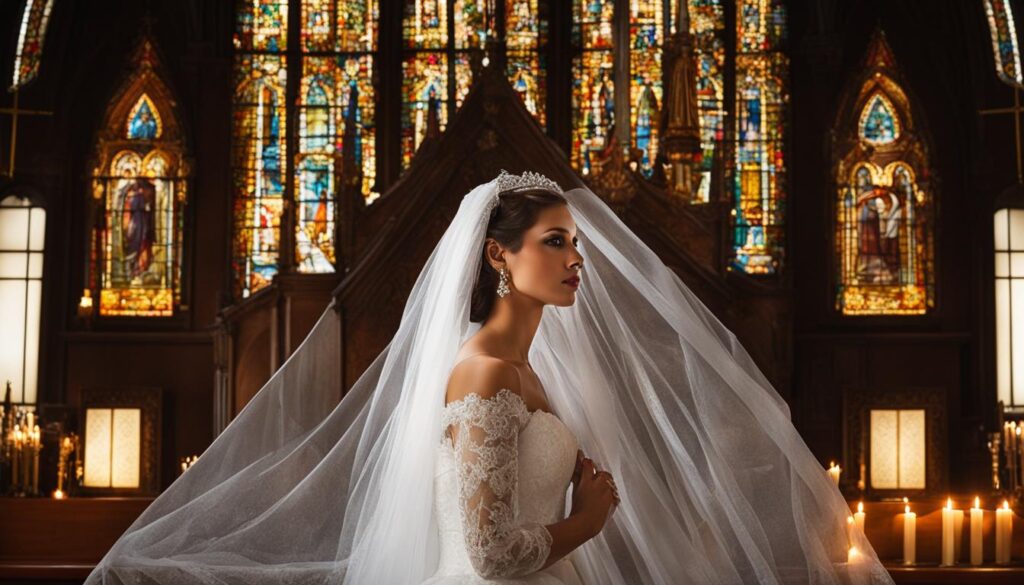
Alternatives to Chapel Veils or Mantillas for the Reception
For brides who prefer to remove their chapel veil or mantilla for the reception, there are several alternatives that can maintain the bridal look without the hassle of a longer veil. One option is to swap the cathedral length veil for a shorter blusher or birdcage veil. These styles provide a more practical and comfortable option for moving around and dancing during the reception.
Swapping to a shorter veil allows the bride to maintain the elegance and tradition of wearing a veil without the risk of it being stepped on or causing any damage to the veil or hairstyle. Additionally, shorter veils can be more versatile in terms of hairstyle options and may be easier to manage throughout the evening.
When considering veil length options, it’s important to find a balance between personal style and practicality for the reception. Discussing potential alternatives with a bridal consultant or stylist can help brides make an informed decision based on their specific preferences and wedding plans.
Table: Comparison of Veil Length Options
| Veil Length | Style | Advantages |
|---|---|---|
| Cathedral Length | Classic and formal | Elegant and traditional |
| Blusher or Birdcage | Retro and vintage-inspired | Allows for easy movement and dancing |
| Elbow Length | Versatile and timeless | Works well with most wedding gown styles |
| Fingertip Length | Chic and modern | Creates a balanced look with many dress silhouettes |
| Shoulder Length | Contemporary and sophisticated | Provides a more casual and approachable look |
Ultimately, the decision to remove the veil for the reception and choose an alternative is a personal one. Brides should feel comfortable and confident in their choice, knowing that it reflects their individual style and allows them to fully enjoy their wedding day festivities.
Conclusion
Chapel veils or mantillas are timeless and elegant accessories that add a touch of tradition and sophistication to a bride’s wedding day look. With their rich history and cultural significance, these veils symbolize respect for religious customs and can be an ideal choice for brides who want to honor their heritage.
Whether it’s the intricate lace, the draping scalloped edge, or the personalized embellishments, chapel veils or mantillas offer brides the chance to showcase their unique style and enhance the beauty of their wedding attire. These veils are a symbol of grace and elegance, reflecting the deep-rooted traditions associated with Christian prayer tools.
Explore the extensive collection of chapel veils or mantillas to find the perfect accessory to enhance your elegance and tradition on your special day. With a wide range of designs, lengths, and materials, there is a chapel veil or mantilla to suit every bride’s style and preference. Embrace the beauty and symbolism of these cherished prayer tools, and let them add an extra touch of grace to your wedding day ensemble.
FAQ
What is a chapel veil or mantilla?
A chapel veil or mantilla is a circular veil with a lace trim around the entire edge, traditionally worn by Spanish, Latin, and Italian brides. It is also worn during Mass, with black veils worn by married or widowed women and white veils worn by unmarried women.
Are chapel veils or mantillas only worn by Catholics?
While chapel veils or mantillas have roots in Catholicism, they can be worn by anyone, regardless of religious affiliation. Their use varies across different Christian sects and cultural traditions.
What fabrics are used to make chapel veils or mantillas?
Chapel veils or mantillas are typically made from delicate lace with scalloped trim. However, other fabrics such as tulle and netting can also be used to provide different textures and styles.
How have chapel veils or mantillas evolved over time?
Chapel veils or mantillas have seen changes in design and embellishments over time. Modern brides can choose from a variety of lengths, lace patterns, and personalized touches like beads and embroidery.
What are some lesser-known chapel veil or mantilla variations?
Some lesser-known variations include birdcage veils, blusher veils, and shoulder-length veils, offering brides more versatility in their choice of veil style.
How do you choose the right chapel veil or mantilla for your wedding dress?
It is important to consider how the lace on the veil coordinates with the lace or embellishments on your gown. The hairstyle you choose will also determine the placement of the veil.
How do you wear and secure a chapel veil or mantilla?
Chapel veils or mantillas are typically worn at the top of the head, secured with a hidden comb or pin. It is essential to use bobby pins that match the hair color to prevent slipping during the ceremony.
Can you wear a chapel veil or mantilla during the reception?
Some brides choose to remove their veils for the reception for ease of movement and dancing. If the veil is a cathedral length, it can be replaced with a shorter blusher or birdcage veil for the reception.
What is the significance of chapel veils or mantillas?
Chapel veils or mantillas symbolize respect for the sacredness of the occasion and the covering of the bride’s shoulders during mass. They also carry cultural and traditional significance in many communities.
How can chapel veils or mantillas enhance a bride’s wedding day look?
Chapel veils or mantillas add a touch of tradition and sophistication to a bride’s attire. Their intricate lace, draping scalloped edge, and personalized embellishments can enhance the beauty and elegance of a bride’s wedding day look.
Where can I find a chapel veil or mantilla?
Chapel veils or mantillas can be found in bridal boutiques, online retailers, and specialty stores that cater to bridal accessories. It is important to explore different options to find the perfect veil to enhance your elegance and tradition on your special day.







